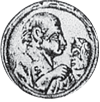Commedia dell’arte și grummelot-ul
Keywords:
acting, dialectsAbstract
Commedia Dell’Arte and the Grammelot
Commedia dell’Arte appeared in the 16th century in Italy. This theatrical genre expanded its existence for over two and a half centuries. Nevertheless, the true term “Commedia dell’Arte”, in other words, its structure into a theatrical genre, is the theatrical form practiced during the 18th century. The name itself highlighted especially the professional aspect of this theatrical genre, as opposed to the occasional representations delivered by amateur theatre groups. At the end of the 17th century, the Italian actors were cast away from the Parisian stages, resulting in many of them performing in markets, at fairs, and even in the outskirts of the cities. This is when the grammelot, as an acting technique, starts playing a significant part on the stage of the commedia dell’arte. The technique of the grammelot has been an extremely generous source of inspiration for artistic expression in the case of Commedia dell’Arte actors, thus giving birth to numerous scenes based on the grammelot-technique.
References
APOLLINO, Mario, 1981, Storia della Commedia dell’Arte, Firenze, Sansoni.
BAHTIN, Michail, 1970, L’oeuvre de Fr. Rabelais et la culture au Moyen Age et sous la Renaissence, Paris, Univers
BARBA, Eugenia și SAVARESE, Nicola, 2012, Arta secretă a actorului. Dicționar de antropologie teatrală, Traducerea de Vlad Russo, București, Humanitas
BATY, Gaston și CHAVANCE, Rene, 1969, Viața artei teatrale, traducere Sanda Râpeanu, București, Meridiane;
BERLOGEA, Ileana, 1970, Teatru Medieval Europen, București, Meridiane;
BIALOSTOCKI, Jan, 1977, O istorie a teoriilor despre artă, Traducerea de Anca Irina Ionescu, , București, Meridiane;
BROWN, John Russel, 2016, Istoria teatrului universal. Ediție ilustrată, Traducerea de Dana Ionescu, Adriana Voicu și Cristina Maria Crăciun, București, Nemira;
CHAFFEE, Judith & CRICK, Oliver, 2014, The routledge companion to Commedia dell’Arte, New York Routledge;
DE AMICIS, Vincenzo, 1987, L’imitazione latine nella Commedia Italiana del XVI secolo, Firenze, G.C.Sansoni;
DRÂMBA, Ovidiu, 2000, Istoria teatrului universal, București, Saeculum I.O;
ESRIG, David, 2016, Commedia dell’Arte- O istorie a spectacolului în imagini, București, Nemira.
MĂLAIMARE, Mihai, 2011, Commedia dell’Arte, clipa astrală a teatrului universal, București, Tracus Arte;
MĂRCULESCU, Olga, 1984, Commedia dell’Arte, București, Univers;
PANDOLFI, Vito, 1971, Istoria Teatrului Universal, vol. II, București, Meridiane;
PANOFSKI, Erwin, 1974, Renaștere și renașteri în Arta occidentală, Traducerea de Sorin Mărculescu, București, Meridiane;
PERRUCCI, Andrea, 1982, Despre arta spectacolului dinainte gândit și despre improvizație,traducere de Olga Mărculescu, București: Meridiane;
PERRUCI, Andrea, 2008, A treatise on acting,from memory and by improvisation, Londra Ed.Scarecrow Press;
PROCACCI, Giuliano, 1975, Istoria italienilor, Traducere de Dumitru Trancă, , București, Editura politică;
RUDLIN, John, 1994, Commedia dell’Arte, an actor’s handbook, New York Routledge;
SAND, Maurice, 1918, The history of the Harlequinade, London: Martin;
TAVIANI, Ferdinando, 1970, La Commedia dell’Arte e la societa barocca, Roma, Bulzoni Editore;
TAVIANI, Ferdinando; SCHINO Mirella, 1982, Il segretto della Commedia dell’Arte- la memoria delle com-pagnie italiana del XVI-XVII e XVIII secolo, Firenze, Usher;
ZAMFIRESCU, Ion, 1958, Istoria universală a teatrului. Antichitatea, Volumul I, București, Editura de stat pentru literatură și artă;
ZAMFIRESCU; 1966, Istoria Universală a teatrului. Evul Mediu și Renașterea, Volumul II, , București, Editura pentru Literatură Universală
Downloads
Published
How to Cite
Issue
Section
License

This work is licensed under a Creative Commons Attribution 4.0 International License.
CC-BY permits any use, reproduction, distribution, self-archiving and citation of the work as long as the authors are credited. The complete bibliographical data of Symbolon Journal must also be indicated, which you can find in the How to cite section on this page. If possible, please also place a link leading to the original publication.
Copyright of the paper belongs to the author(s).




